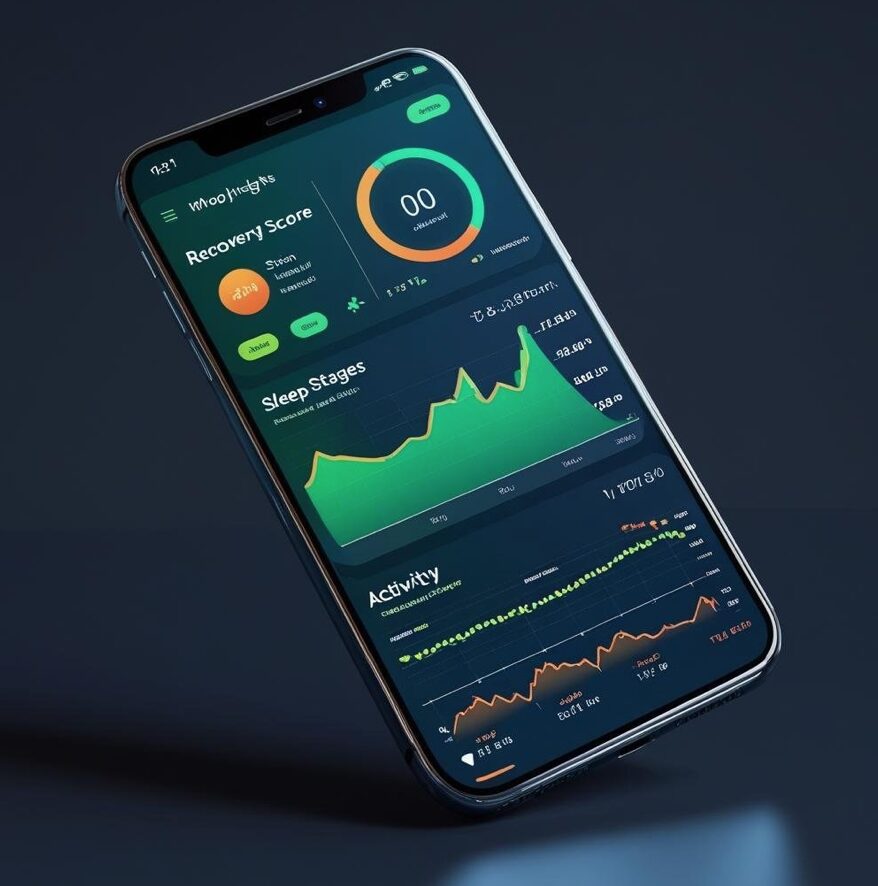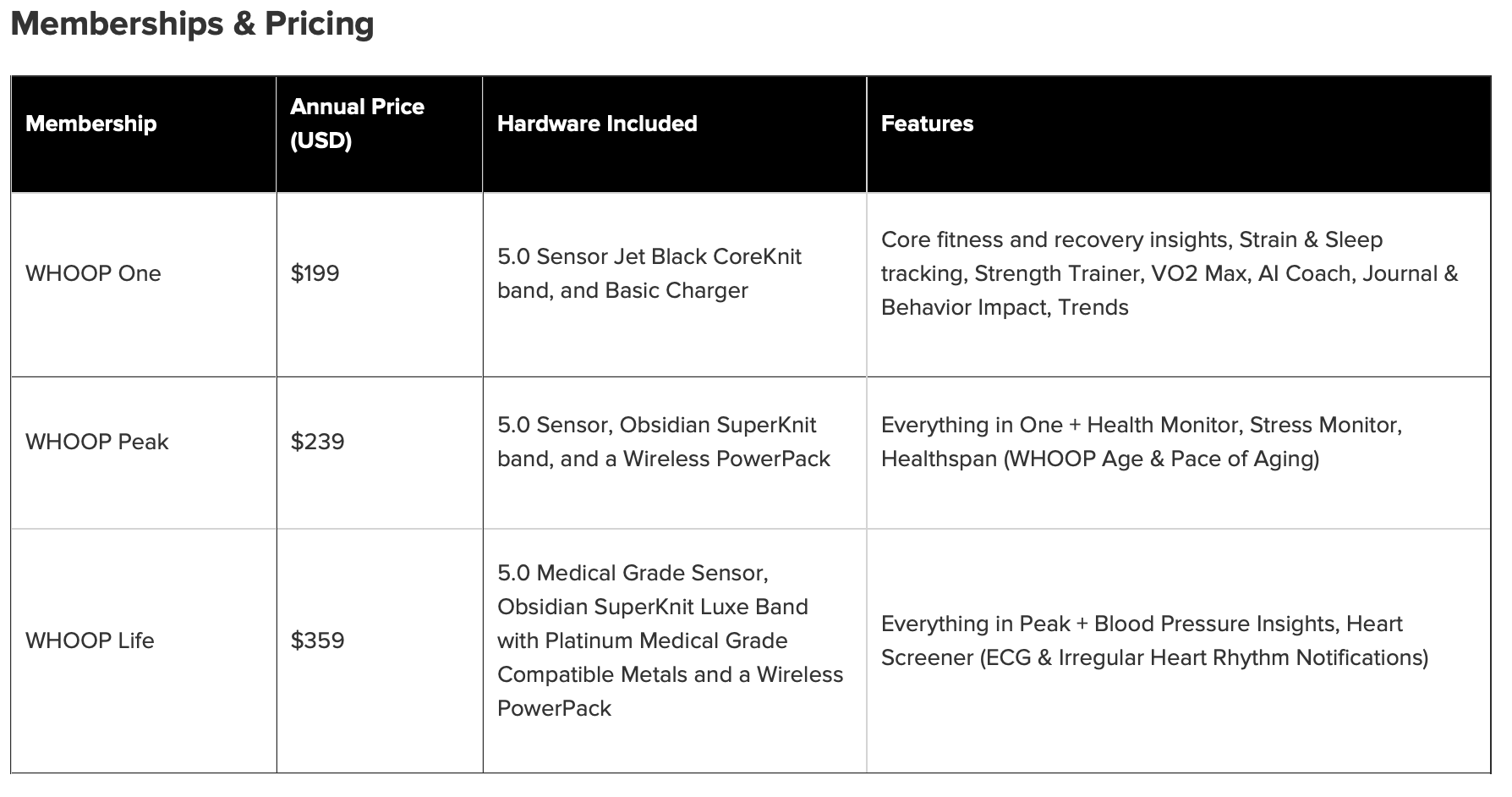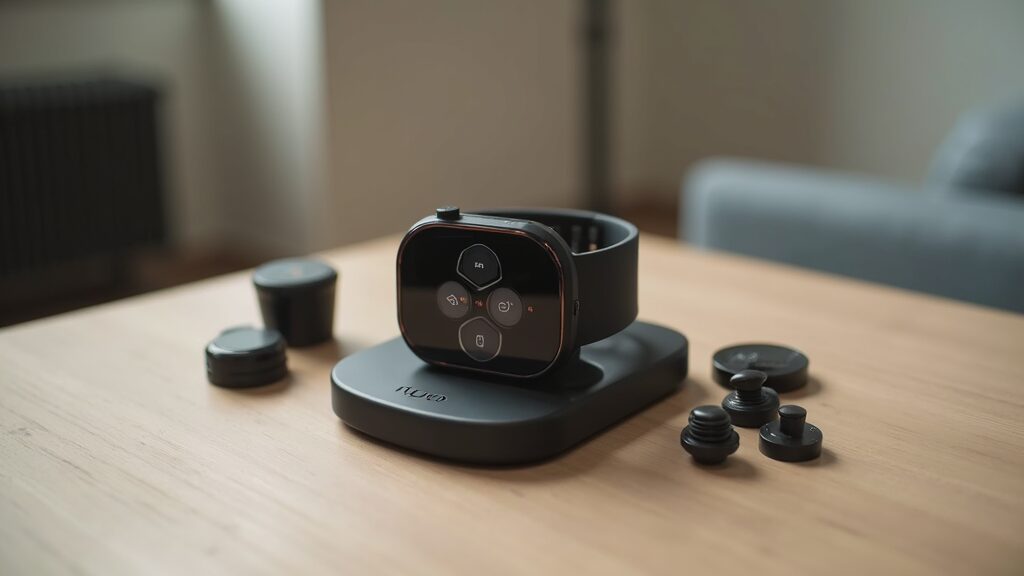WHOOP has turned into a popular choice for folks who want to get serious about tracking their health and fitness over the long haul. This wearable carves its own lane in the fitness tracker space. Instead of chasing bright screens and a parade of notifications, WHOOP zooms in on what matters for those who care about physiology, helping you get a pulse on your workout recovery, sleep, daily strain, and overall readiness. If you’re about to put down money for a new fitness wearable, there are some important things to consider about WHOOP before you hit “buy.”
Here’s an honest review built from months of hands-on use, sifting through feedback in the WHOOP community, and really checking out what makes this band stand out. I’ll break down its unique edge, where it shines, a few minor headaches, what real users say, and essential considerations to weigh before tapping in. Want the full story? Keep reading.
Product: WHOOP Wearable 4.0
Official Website: whoop.com
Pricing: Membership-based, $199/annual or $25/month WHOOP One, $264/annual or $30/month WHOOP Peak, $359/annual or $40/month WHOOP Life
Included: Band, sensor, charger pod, access to WHOOP app and data
Free Trial: 30 days
Battery Life: Up to 14+ days
Sensor Type: Optical, Pedometer, Pulse Sensor
User Reviews: 2.9/5 (Trustpilot), 4.5/5 (App Store, average)
Recommended For: Athletes, fitness enthusiasts, people who are serious about recovery and sleep
Note:
- Monthly pricing is only available for tenured members. New members must enroll in an annual membership. Some features, like Healthspan, ECG, and IHRN require a certain device model in order to unlock.
- Month to Month subscriptions are no longer available as a standard signup option but remain accessible in select renewal scenarios. If you are a current Month to Month member, you are welcome to stay on your monthly membership! If you wish to upgrade you can do so by paying a one-time upgrade fee
- New members can select a 24-month membership when signing up.
Source information about pricing: WHOOP page
What’s in the post:
- TL;DR: What to Know About the WHOOP Wearable
- WHOOP Wearable: Fun Facts
- The Story Behind WHOOP: Roots and Rise
- How WHOOP Works: The Essentials Explained
- WHOOP’s Deep Features: What Sets It Apart
- Comfort, Fit, and Everyday Use: Wearing WHOOP Daily
- How WHOOP Measures Up: Data Quality & Accuracy
- WHOOP Membership: Breaking Down the Costs
- WHOOP vs. Alternatives: How Does WHOOP Stack Up?
- WHOOP Trivia: Cool Things You Might Not Know
- User Feedback: What WHOOP Owners Are Saying
- My Personal Take: WHOOP After 4 Months
- Should You Try WHOOP? The Best Fit
- WHOOP FAQs: What People Ask Most
- Wrapping Up: Is WHOOP the Real Deal?
TL;DR: What to Know About the WHOOP Wearable
- WHOOP is a fitness band that tracks strain, recovery, and sleep, all without a screen.
- – It narrows the focus to high-quality data, works entirely via a subscription, and stands out for eye-catching recovery analytics.
- – Some people love having in-depth numbers, while others don’t enjoy the continuing price or missing smartwatch perks.
- – Reliability and comfort are both strong points, and the app is well designed for digging into your stats.
- – The question to weigh: Do you want distraction-free, data-powered training and are you on board with an ongoing subscription model instead of a simple one-time hardware buy?
WHOOP Wearable: Fun Facts
WHOOP was first designed as a recovery monitor for college athletes before fitness fanatics everywhere picked it up.
The band has no screen at all. You’ll view your stats only in the app.
The sensor can slide into unique WHOOP clothing, meaning it’s built for tough workouts, including swimming and contact sports.
WHOOP is among the few wearables that spot both overnight sleep and daytime naps, handy for anyone with a wild schedule.
The device is completely water resistant. Drip, soak, or splash, no problem.

The Story Behind WHOOP: Roots and Rise
WHOOP isn’t your run-of-the-mill tech brand. It rose from a need for better monitoring of recovery in competitive athletes, brainchild of Will Ahmed. The product’s first wave of users were college and professional athletes, but as the buzz grew, weekend warriors and dedicated fitness fans came on board looking for science-driven feedback. The idea was to go deeper than basic trackers, making sure you understood not only how much you moved but how well you recovered.
Personally, I decided to test WHOOP after hearing my local running group rave about its sleep scoring and readiness coaching. Their stories, how WHOOP flagged days they felt sluggish, or how recovery scores made a noticeable difference in injury prevention, caught my attention. My first impression matched those claims: this was not a surface-level step counter.
Today, WHOOP is used globally by everyone from everyday gym to pro athletes. Its app continues to evolve, new band styles launch every year, and the company regularly puts out “insight” deep dives and team challenges. WHOOP’s story is about giving people high-quality knowledge to train smarter and minimize burnout.
How WHOOP Works: The Essentials Explained
WHOOP runs on a subscription game plan. You don’t buy the hardware in the traditional sense, instead, you get the band when you sign up for their monthly service. As long as you have an active subscription, you keep your access. When a new band model comes out, upgrading is automatic for renewing members, so you’re never left with outdated hardware gathering dust.
The hardware: a minimalist, screen-less band collects three vital data buckets:
- Strain: A score based on your cardiovascular effort throughout both workouts and day-to-day activity
- Recovery: A rolling score, heavily powered by heart rate variability (HRV), resting heart rate, respiratory rate, sleep numbers, and your previous day’s stress
- Sleep: Tracks sleep duration, sleep stage breakdown (deep, light, REM), consistency, debt, and overall efficiency
WHOOP is made for 24/7 wear: sweat, swim, shower, or sleep, you won’t need to remove it except to switch out bands. A slide-on battery charger pod means you never miss a recording session just because you’re juicing up the battery.

WHOOP’s Deep Features: What Sets It Apart
You won’t find games or touch controls here, but the details WHOOP tracks are super detailed and revealing. Here’s a breakdown:
- Screenless Style: No texts, notifications, or pop-up messages to kill your focus, just a slick, minimal, “wear it and forget it” design.
- 24/7 Tracking: WHOOP samples heart rate extremely frequently, takes in blood oxygen readings, skin temperature, and even respiratory data, going far beyond most wearables’ metrics. This gives you clinical-level feedback without complicated setups.
- Dynamic Strain Coach: Each morning, WHOOP checks your recovery stats and suggests how hard (or easy) you should go during training. It helps you avoid overdoing things and can be a game changer for injury prevention.
- Sleep Coaching: Tracks not just how long you’re out, but also stages, patterns, and trends, then recommends the best time for heading to bed or squeezing in a nap.
- Health Monitor Suite: See real-time dashboard trends for respiration, blood oxygen, heart rate, and temperature; key for picking up on overtraining, coming down with an illness, or changes in routine stress.
- App-Based Community: The WHOOP app lets you form teams, challenge friends, even join group leaderboards, adding some extra motivation to hit your goals.
- Battery Smarts: The slide-on, water-resistant charger pod means you power up without missing a beat. It’s one less thing to stress about if you’re chasing streaks.
Comfort, Fit, and Everyday Use: Wearing WHOOP Daily
WHOOP’s textile band is lighter and slimmer than nearly every other tracker I’ve tried. It doesn’t feel techy; more like a comfy wristband. The fabric breathes well, even after a sweaty workout or a swim, it dries fast. The band’s adjustability, plus loads of styles (leatherluxe, sportflex, cloudknit, superknit, coreknit, whoop body), lets you pick a look you’ll actually want to wear all day, every day.
I’ll admit: not having a display took some adjusting. You’ll need your phone for time checks or notifications, which some might find inconvenient. But once I adapted, I preferred this cleaner approach, no glances or buzzes interrupting focus at the gym or work. For those who love gadgetry, though, keep in mind that WHOOP is not playing in the smartwatch playground. If you want maximum feedback through the app and minimal distractions on your wrist, this is a nearly perfect fit.

How WHOOP Measures Up: Data Quality & Accuracy
WHOOP is open about its data methods; several peer-reviewed validation studies show its sleep detection and HRV readings land very close to clinical benchmarks. In my experience, sleep efficiency reports and recovery scores mostly mirrored my own sense of rest and performance. When I felt “off,” the data flagged it—the system picked up on rough nights or high stress days well before minor aches or decrease in exercise enjoyment hit.
The band’s ability to highlight subtle changes in respiration or skin temperature came in clutch more than once; it turns out those changes are reliable early warnings for cold or illness. Meanwhile, the strain coach matched up with day-to-day motivation. helpful for dialing back instead of pushing needlessly and risking overuse injuries.
WHOOP Membership: Breaking Down the Costs
The pricing system might catch some people off guard. There’s no big upfront bill for hardware, you pay a recurring fee to tap into everything WHOOP offers. The breakdown:
- $199/annual or $25/month WHOOP One
- $264/annual or $30/month WHOOP Peak
- $359/annual or $40/month WHOOP Life
A fresh band, charger, and sensor are included, with plenty of optional accessories or premium straps available for a bit extra. The longer you stick with the service, the more value you get, especially since active members get next-level cool hardware upgrades along the way, avoiding the pain of hardware getting old and irrelevant in just a year.

Image source: Whoop
WHOOP vs. Alternatives: How Does WHOOP Stack Up?
WHOOP faces stiff competition from the likes of Garmin, Fitbit, Apple Watch, and the Oura Ring. Here’s how it compares:
- Garmin/Fitbit/Apple Watch: These devices bring loads of features: touchscreens, music, smart notifications, GPS. But they often focus more broadly, rarely matching WHOOP’s super detailed recovery and readiness tracking or heart rate variability insights. If you love phone features or need instant data at your fingertips, these might edge out WHOOP for you.
- Oura Ring: Both WHOOP and Oura dig deep into sleep and recovery. Oura’s ring format is unobtrusive and pay-once, whereas WHOOP goes the extra mile with daily strain advice and more personalized coaching. WHOOP appeals more if you want comprehensive, fine-tuned training support.
- Polar: Known for its endurance sport accuracy, Polar delivers advanced HR, often favoured by serious cyclists or triathletes. WHOOP, however, courts a broader fitness set and focuses relentlessly on recovering right, not just going hard.
If your quest is for a cross between a wellness wearable and daily-use smartwatch, WHOOP might not be your winner. But if you want actionable insights, daily readiness, and a customizable approach to coaching, WHOOP is absolutely worth a test drive.
WHOOP Trivia: Cool Things You Might Not Know
- Top-tier athletes, NBA stars, Olympic swimmers, golf champions, are among WHOOP’s superfans.
- WHOOP’s data isn’t just marketing, the company’s research team publishes academic papers on HRV, sleep, and new metrics openly.
- You’re not limited to your wrist; WHOOP offers bicep wear and even clothing with built-in pockets for the sensor.
- Many elite CrossFit gyms use WHOOP to dial in group training loads and recovery.
User Feedback: What WHOOP Owners Are Saying
I always like to look over reviews from every angle before purchasing tech. Here’s a snapshot from across review sites, forums, and the WHOOP app group:
Highlights from Happy WHOOPers
- “Sleep tracking blows other trackers away. I changed how I train because I stopped guessing on recovery.”
- “Comparing WHOOP’s HRV readings with clinical gear at work, it’s extremely close and consistent.”
- “Charging is ridiculously simple; one less thing to worry about.”
- “Support is fast; got a new band overnight after mine broke.”
- “App groups totally change how I stick with new habits. The challenges are fun, and I actually learn from the insight reports.”
Cautions and Complaints
- “Wish there was a way to own it outright. Subscriptions can add up after a few years.”
- “Why did you pick this product vs others?:
Like the other reviews said, not worth a subscription that you are forced to sign up for. If you want something like this, go buy a smart watch instead. I haven’t called to cancel my subscription yet, but judging from the other reviews I can only imagine how bad it’s going to be.” - “Setup was tricky, took time to adjust the band and get the app synced.”
- “Missing a screen is inconvenient at times. I can’t see my heart rate mid-workout.”
- “You have to keep paying or you lose all access instantly. That feels a bit too strict.”
- “If you want a feature-packed smart device, WHOOP will leave you wanting more.”
Most strong reviews focus on high data quality, better habit building, and the satisfaction of deep health tracking. Less-positive comments mainly zero in on the subscription commitment and a lack of instant-read or notification features.
My Personal Take: WHOOP After 4 Months
Wearing WHOOP for over 120 days, here’s the straight story:
- Reliable Data = Real Results: My sleep and recovery improved, and I didn’t guess when I needed a rest or a run. I noticed better energy on days I actually heeded the strain coach advice. Post-workout soreness and skipped sessions dropped for me as a result.
- Battery and Wearability: No sweaty build-up, easy to clean, no break in tracking to recharge, WHOOP’s comfort after rides or runs is a win versus chunkier wearables.
- No Buzz, No Fomo: I got fewer interruptions. Honestly, I was less distracted at work and in workouts without extra notifications.
- Learning Curve: The first two weeks took patience, so many new numbers, acronyms, and deep-dive reports. Fortunately, WHOOP’s FAQs and forums help, but beginners should prep for some info overload at first.
What didn’t thrill me: I kept reaching for my wrist out of habit, only to remember the time and details live in the app. That took some getting used to, as did being “off-grid” from phone notifications. But the high-value analytics and reminders to step up my recovery felt worth the tradeoff for me after the first month.
If you are not used to wear a watch, you will probably don’t like WHOOP.
Should You Try WHOOP? The Best Fit
WHOOP is ideal if you:
- Crave next-level cool fitness tracking, not just basic steps
- Want to boost workout performance and recovery with data-driven feedback
- Are coming back from injury, or balancing training with busy work/life schedules
- Like building healthy sleep and recovery habits
WHOOP might not be for you if:
- You can’t stand the thought of a forever subscription
- You need real-time data or smart features on your wrist at all times
- Your workouts never change, or step-counting is all you want
- You’re looking for an all-in-one smartwatch plus health tracker
Test drive WHOOP for a full month at no charge
WHOOP FAQs: What People Ask Most
How is the battery?
WHOOP is designed to last over 14 days on a single charge, but users have reported varying experiences, with some only getting around 7 days. Pop the pod on, no need to remove the band.
Does it have GPS or step counts?
No built-in GPS; WHOOP tracks effort and heart rate only (strain). For routes, open another app or device while working out.
Can you sync with Strava, Apple Health, or Google Fit?
WHOOP syncs cleanly, sharing sleep, HR, and strain. Cyclists may still want a dedicated GPS for full ride analytics.
Do you need the subscription?
Absolutely! The app, analytics, and data access are all tied to your membership. Cancel and you lose the tools (but your history is there if you rejoin).
Does it work with iOS and Android?
Yes, there are apps for both, plus a solid web dashboard.
How accurate is it, really?
WHOOP’s biometrics, especially sleep and HRV, are well-backed by academic validation. That said, nothing short of a medical sleep lab is perfect, but WHOOP is a leader for wrist-based devices.
Can I try it first?
Yes. New members can test drive WHOOP for a full month at no charge before making the long-term decision.
Wrapping Up: Is WHOOP the Real Deal?
If you want a fitness wearable that goes deeper on data, coaching, and recovery than almost any other tracker out there, WHOOP makes an eye-catching case. The monthly (or yearly) cost covers more than just hardware, you’re getting ongoing research, community features, and regular software and device updates, so your investment stays relevant.
Is WHOOP perfect for everyone? Definitely not. Folks looking for smartwatch perks or who cringe at the idea of ongoing payments won’t fall in love. But for data lovers, athletes, and anyone willing to use metrics to train smarter, rest better, and avoid overtraining, WHOOP is a unique tool that grows with you. Over time, the subscription can easily pay for itself by supporting injury prevention, building better habits, and giving you a real edge over the standard fitness band crowd.
If you’ve got questions about WHOOP or want to compare your own experience, drop a comment below and let’s get into it, happy to help out!



